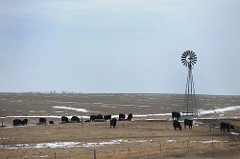Released: March 9, 2017
Water, feed critical for cattle affected by wildfires
K-State beef systems specialist offers tips for affected ranchers and their herds.

GARDEN CITY, Kan. – A Kansas State University expert is underscoring the critical need to get water and reliable feedstuffs to cattle in the aftermath of wildfires that have ravaged many parts of southern and western Kansas.
As of Thursday morning, the wind-whipped fires had scarred nearly 660,000 acres in 21 counties and forced numerous evacuations and road closures. The number of livestock and wildlife that have died in the fires is not yet known.
Justin Waggoner, a beef systems specialist in southwest Kansas, said the fires have crippled systems that are ordinarily used for getting water to cattle.
“Here in the western part of the state, we rely very heavily on groundwater resources,” he said. “Most of our watering sites for cattle on native range are going to be some sort of developed well system, which might be powered by a windmill, or solar pump. The functionality of those after fires is going to be limited in some capacity.”
In some cases, producers may be forced to haul water to thirsty cattle.
“The rule of thumb is to provide 1 gallon of water per 100 pounds of body weight for non-lactating cows,” Waggoner said. “So for a 1,400 pound cow, 10-14 gallons of water per day is what it’s going to take to meet those requirements.”
In areas where cropland has been spared from fire, wheat pasture or crop residues may be an option. There are also hay relief efforts taking place in many areas to help producers feed their herds.
The abrupt dietary switch to wheat pasture, however, may raise concerns about grass tetany.
“We do have a short window of time to work with before we would see the onset of that,” Waggoner said. “One of the things we can do to alleviate that is to supply a high magnesium mineral in those situations. Magnesium absorption is linked to sodium. So if a high magnesium mineral is not available, having a good supply of salt out there — and making sure the cattle are consuming salt — will help magnesium absorption and help to alleviate those concerns.”
Waggoner added that producers should take an inventory of animals with the highest energy requirements versus those with lower requirements and allocate hay and other resources to the most appropriate animals.
“In some cases, we can use higher-quality forages and feed those in a limited amount to carry them further and utilize more of the lower quality hay that we may have available to stretch available forage resources, essentially using the highest-quality hay as supplement,” he said.
As a guideline, the typical intake for each cow is approximately 2 percent of their body weight per day, or about 28-32 pounds of hay or forage per day to each cow.
“Once we get into long-term feeding, another option might be to look at feeding and utilizing by-product feedstuff or some sort of supplement to balance out the hay that we’re feeding those cattle,” Waggoner said. “It’s about meeting their requirements for energy and protein.
“Small amounts of grain may be used, even though it is high in starch, to help meet those requirements.”
Waggoner said it’s also important for producers affected by the fires to know that they’re not alone.
“There are people that are here to help, whether that’s a need for hay or any sort of assistance, fence rebuilding, fence supplies or whatever,” he said. “Don’t hesitate to ask for help. There are a tremendous amount of resources available at their disposal.”
K-State Research and Extension agents are available throughout the state to help producers. Visit www.ksre.ksu.edu to find your local office.
K-State Radio Network Agriculture Director Eric Atkinson hosts an audio interview with Justin Waggoner at: http://bit.ly/2mpFBqM
-30-
K‑State Research and Extension is a short name for the Kansas State University Agricultural Experiment Station and Cooperative Extension Service, a program designed to generate and distribute useful knowledge for the well‑being of Kansans. Supported by county, state, federal and private funds, the program has county Extension offices, experiment fields, area Extension offices and regional research centers statewide. Its headquarters is on the K‑State campus in Manhattan.
For More Information:
Justin Waggoner – 620-275-9164
jwaggon@ksu.edu
Pat Melgares – 785-532-1160
melgares@ksu.edu
K-State Research and Extension
www.ksre.ksu.edu
